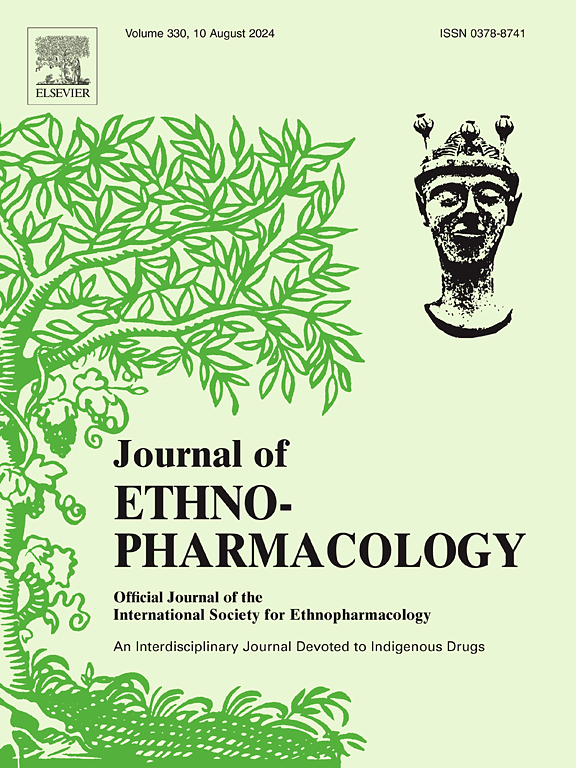Yinchenhao Tang exerts an inhibitory effect on the influenza a virus by modulating the JAK/STAT signaling pathway
IF 4.8
2区 医学
Q1 CHEMISTRY, MEDICINAL
引用次数: 0
Abstract
Ethnopharmacological relevance
Yinchenhao Tang (YCHT), a traditional Chinese medicine (TCM), consists of Yinchen, Zhizi, and Dahuang. For over a millennium, it has been widely used in the treatment of liver disorders and jaundice. Furthermore, numerous studies have highlighted its anti-inflammatory, immunomodulatory, and antiviral properties. However, the specific active constituents and the involvement response to influenza virus infection remain unclear.
Aim of the study
The present study aims to explore the YCHT’ s antiviral and anti-inflammatory abilities, and further clarify the possible mechanisms underlying such effects.
Materials and methods
In vitro and in vivo studies were performed to confirm the anti-influenza and anti-inflammatory abilities of YCHT. Ultra-Performance Liquid Chromatography-Quadrupole Orbitrap High-Resolution Mass Spectrometry (UPLC-Q-Orbitrap HRMS) analysis was used to determine the active components and mechanism of YCHT. The potential mechanisms exert its anti-influenza virus effects were investigated via network pharmacology and molecular docking, and the results of cell cytokines and signaling pathways were elucidated by Western blot.
Results
The findings showed that YCHT increased the survival rate of virus-infected mice, reduced viral titers in lung tissue and improved lung pathology. Moreover, in viral-infected A549 cells and pulmonary tissues, inflammatory cytokine expression was suppressed. A total of 26 active compounds were identified in the serum of infected mice in the YCHT treatment group. According to experimental research, molecular docking, and network pharmacology, YCHT inhibits the JAK/STAT signaling pathway to provide its anti-influenza effects.
Conclusions
This study verified YCHT could prevent the production of inflammatory cytokines after influenza A virus infection and relieve the pneumonia via the regulation of JAK/STAT signaling pathway.
银宸浩汤通过调节JAK/STAT信号通路对甲型流感病毒产生抑制作用。
民族药理学相关性:银陈好汤是一种中药,由银陈、栀子和大黄组成。一千多年来,它被广泛用于治疗肝脏疾病和黄疸。此外,许多研究都强调了它的抗炎、免疫调节和抗病毒特性。然而,具体的活性成分和对流感病毒感染的参与反应尚不清楚。研究目的:本研究旨在探讨YCHT的抗病毒和抗炎能力,并进一步阐明其作用的可能机制。材料和方法:通过体外和体内实验证实了YCHT的抗流感和抗炎能力。采用超高效液相色谱-四极杆轨道阱高分辨率质谱(UPLC-Q-Orbitrap HRMS)分析YCHT的有效成分及作用机理。通过网络药理学和分子对接研究其抗流感病毒作用的潜在机制,并通过Western blot分析其细胞因子和信号通路的作用结果。结果:YCHT提高了病毒感染小鼠的存活率,降低了肺组织中的病毒滴度,改善了肺部病理。此外,在病毒感染的A549细胞和肺组织中,炎症细胞因子的表达受到抑制。在治疗组感染小鼠血清中共鉴定出26种活性化合物。通过实验研究、分子对接和网络药理学研究,YCHT通过抑制JAK/STAT信号通路发挥抗流感作用。结论:本研究证实YCHT可通过调控JAK/STAT信号通路,抑制甲型流感病毒感染后炎症因子的产生,缓解肺炎。
本文章由计算机程序翻译,如有差异,请以英文原文为准。
求助全文
约1分钟内获得全文
求助全文
来源期刊

Journal of ethnopharmacology
医学-全科医学与补充医学
CiteScore
10.30
自引率
5.60%
发文量
967
审稿时长
77 days
期刊介绍:
The Journal of Ethnopharmacology is dedicated to the exchange of information and understandings about people''s use of plants, fungi, animals, microorganisms and minerals and their biological and pharmacological effects based on the principles established through international conventions. Early people confronted with illness and disease, discovered a wealth of useful therapeutic agents in the plant and animal kingdoms. The empirical knowledge of these medicinal substances and their toxic potential was passed on by oral tradition and sometimes recorded in herbals and other texts on materia medica. Many valuable drugs of today (e.g., atropine, ephedrine, tubocurarine, digoxin, reserpine) came into use through the study of indigenous remedies. Chemists continue to use plant-derived drugs (e.g., morphine, taxol, physostigmine, quinidine, emetine) as prototypes in their attempts to develop more effective and less toxic medicinals.
 求助内容:
求助内容: 应助结果提醒方式:
应助结果提醒方式:


